In multiplications: the decimal point moves to the right as many steps as the number has zeros.
In divisions: the decimal point moves to the left as many steps as the number has zeros.
Multiplication and Division of Decimal Numbers by 10, 100, etc.
Test yourself on multiplying and dividing decimal fractions by 10, 100, etc.!
\( 0.26\times10= \)
Multiplication and division of decimal numbers by ten, hundred, etc.
Multiplying and dividing decimal numbers by , , and even is such a simple matter that, if you practice a little, you will know how to solve these types of exercises even in your sleep! Shall we start?
Multiplication of decimal numbers by , , etc:
The key to this type of multiplication exercises is to remember that the decimal point slides to the right as many steps as there are zeros in the number by which the decimal number is multiplied.
See how simple this is:
We will ask ourselves:
How many zeros does the multiplied number have? (How many zeros are in the number ?) – The answer is .
Therefore, we will move the decimal point one step to the right in this way:
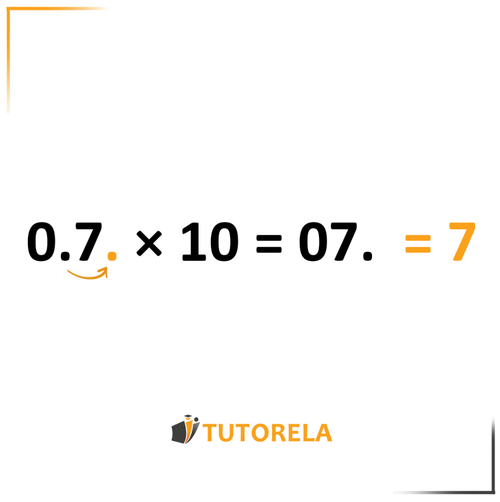
Observe: we have moved the decimal point one step to the right and obtained
The before the means nothing, therefore, we can remove it.
Also, after the decimal point there is nothing, that is, therefore we simply have a !
So, the solution is:
Example 1
We will ask ourselves:
How many zeros does the multiplied number have? (How many zeros are in the number ?) – The answer is .
Therefore, the decimal point will move steps to the right.
We will obtain:
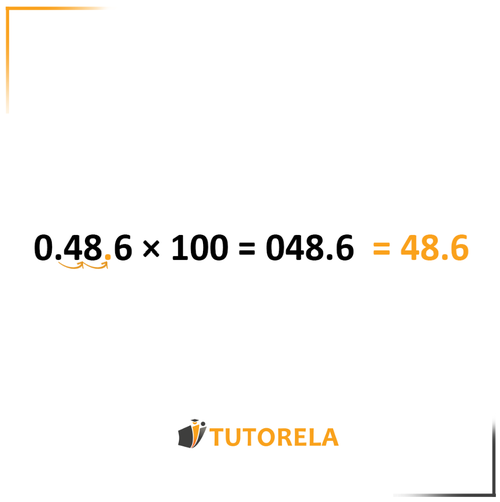
We will realize that the to the right of the point is canceled out, therefore, the answer is:
\( 0.3\times10= \)
\( 0.7\times10= \)
\( 1.004\times10= \)
Example 2
We will ask ourselves:
How many zeros does the multiplied number have? The answer is .
Therefore, the decimal point must be moved steps to the right.
We will move it and obtain:
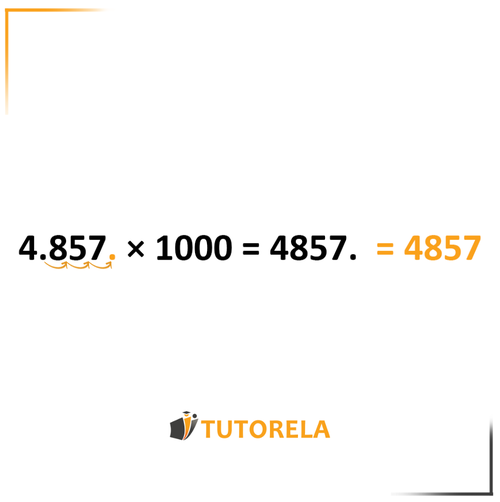
Observe, we have moved the decimal point steps to the right and obtained
There is nothing to the right of the decimal point, that is, there is zero, so the answer will simply be
Example 3
We will ask ourselves:
How many zeros does the multiplied number have? The answer is .
Therefore, we will move the decimal point steps to the right and we will obtain:
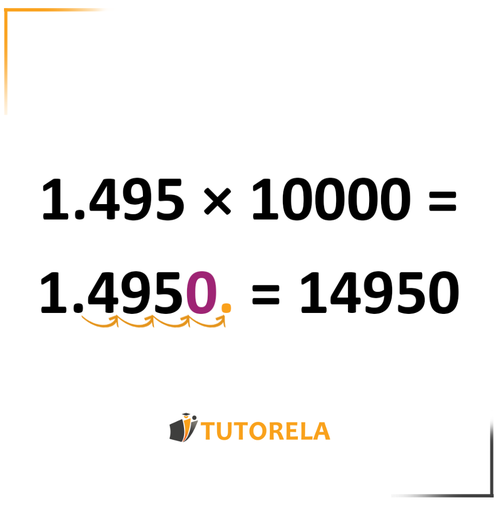
Observe, we have moved the decimal point steps to the right, but we have been left with an empty space to the left of the point.
Then, we will add a in the empty space and we will arrive at the answer being .
\( 111.1:10= \)
\( 11.31:10= \)
\( 1.14\times10= \)
Important aspects
In multiplication
We will move the decimal point to the right.
We will ask how many zeros the multiplied number has, that will give us a clue on how many steps to the right the point should move.
If when counting the steps we see that there is nothing to the right of the decimal point (that is ) we will simply discard the decimal point and the answer will be just the number we obtained.
If we got an answer that leaves an empty space to the left of the decimal point we will add a zero and take it into account for our result.
Division of decimal numbers by , , etc:
The method to solve divisions of decimal numbers by , , etc. is very similar to the way we have learned to solve multiplication exercises.
The only difference is where the decimal point slides.
In these types of division exercises, the decimal point slides to the left as many steps as there are zeros in the number by which the decimal number is divided.
Now let's solve an exercise
We will ask ourselves:
How many zeros does the number by which we are dividing have? (That is )
The answer is .
Therefore, we will move the decimal point step to the left
and we will obtain:
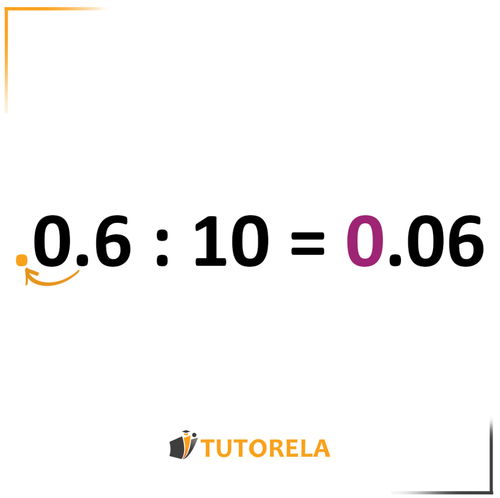
Observe, we have moved the decimal point one step to the left, but there is an empty space to the left of the decimal point, therefore we will fill it with a (marked in green).
\( 12.2:10= \)
\( 13.61:10= \)
\( 1.4\times10= \)
Exercise 1
We will ask ourselves:
How many zeros does the number by which we are dividing have? The answer is .
Therefore, we will move the decimal point steps to the left and we will obtain:
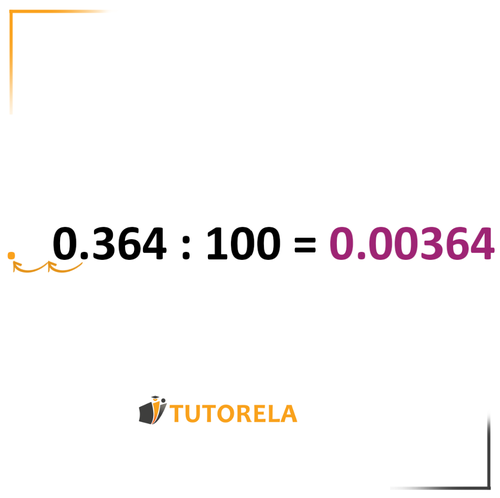
Observe, we have moved the decimal point steps to the left and filled the empty places with .
Exercise 2
How many zeros does the number by which we are dividing have? .
Therefore, we will move the decimal point steps to the left and we will obtain:
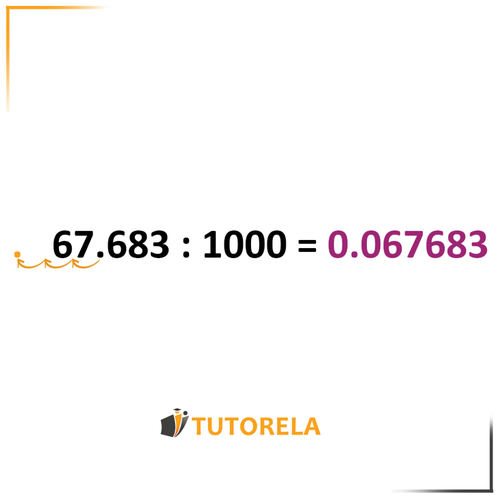
\( 1.52\times10= \)
\( 20.1:10= \)
\( 2.31\times10= \)
Exercise 3
There are zeros, therefore, the decimal point will move steps to the left.
We will obtain:
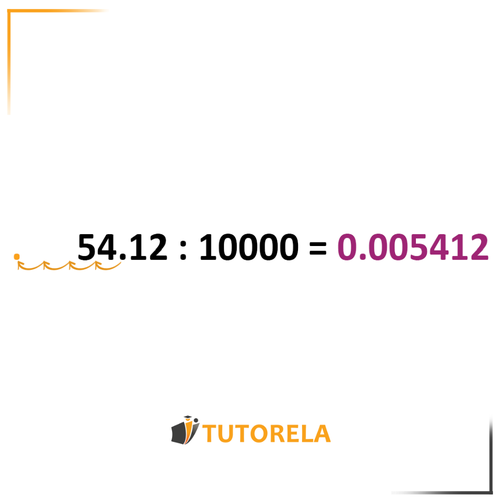
\( 2.66\times10= \)
\( 2.78\times10= \)
\( 0.26\times10= \)
Examples with solutions for Multiplying and Dividing Decimal Fractions by 10, 100, etc.
Exercise #1
Video Solution
Step-by-Step Solution
We will solve the problem by multiplying by . When multiplying a decimal by , the decimal point moves one place to the right.
Let's follow the steps:
- Recognize our initial number: .
- To multiply by , shift the decimal point one position to the right. This changes to .
Therefore, multiplying by gives us the result .
The solution to the problem is .
Answer
Exercise #2
Video Solution
Step-by-Step Solution
To solve this problem, we'll follow these steps:
- Step 1: Understand the operation needed: multiply the decimal 0.3 by 10.
- Step 2: Apply the rule for multiplying by powers of 10.
- Step 3: Execute the operation and write down the result.
Now, let's work through each step:
Step 1: We need to multiply 0.3 by 10. Multiplying by 10 involves shifting the decimal point.
Step 2: Using the rule for multiplying decimals by 10, we shift the decimal point in 0.3 one place to the right.
Step 3: Originally, the decimal point in 0.3 is after the '3'. After shifting it right by one place, we get '3.0'. This is equivalent to .
Therefore, the solution to the problem is .
Answer
Exercise #3
Video Solution
Step-by-Step Solution
To solve this problem, we'll follow these steps:
- Step 1: Identify the given decimal number: .
- Step 2: Recognize that multiplying by shifts the decimal point one place to the right.
- Step 3: Move the decimal point one place to the right from to , which can be expressed simply as .
Now, let's work through each step:
Step 1: We are given the number to multiply by .
Step 2: Multiplying by moves the decimal point one position to the right.
Step 3: Performing this shift, becomes , which simplifies to .
Therefore, the solution to the problem is .
Answer
Exercise #4
Video Solution
Step-by-Step Solution
To solve this problem, we'll follow this straightforward approach:
- Since we are multiplying by , we need to shift the decimal point in the number one place to the right.
Now, let's perform the calculation:
The number has a decimal point after the first digit, and when we shift the decimal one place to the right, it moves between and , resulting in .
Therefore, the product of multiplied by is .
Thus, the solution to the problem is .
Answer
Exercise #5
Video Solution
Step-by-Step Solution
To solve this problem, we'll follow these steps:
- Step 1: Identify the given information: needs to be divided by .
- Step 2: Apply the rule for dividing decimals by 10: shift the decimal point in the number one place to the left.
Now, let's work through these steps in detail:
In Step 1, we confirm that the problem provides the number to be divided by .
In Step 2, we apply the rule of decimal division by shifting the decimal point in one place to the left. This means the decimal moves from between the "111" and the "1" to between the "11" and "11". Thus, the number becomes .
Therefore, the solution to the problem is .
Answer
More Questions
Multiplying and Dividing Decimal Fractions by 10, 100, etc.
- The Order of Basic Operations: Addition, Subtraction, and Multiplication
- Order of Operations: Exponents
- Order of Operations: Roots
- Division and Fraction Bars (Vinculum)
- The Numbers 0 and 1 in Operations
- Neutral Element (Identity Element)
- Order of Operations with Parentheses
- Order or Hierarchy of Operations with Fractions
- Opposite numbers
- Elimination of Parentheses in Real Numbers
- Addition and Subtraction of Real Numbers
- Multiplication and Division of Real Numbers
- Multiplicative Inverse
- Integer powering
- Positive and negative numbers and zero
- Real line or Numerical line
- Mixed Numbers and Fractions Greater Than 1
- Addition and Subtraction of Mixed Numbers
- Multiplication of Integers by a Fraction and a Mixed Number
- Multiplication of Decimal Numbers
- Division of Decimal Numbers
- Repeating Decimal
- Decimal Measurements
- Density
- Remainder of a fraction
- Remainder and Mixed Number
- Remainders
- Order of Operations - Exponents and Roots
- Special cases (0 and 1, reciprocals, fraction line)









